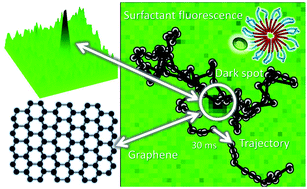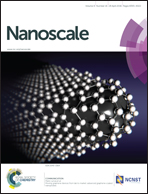Tracking graphene by fluorescence imaging: a tool for detecting multiple populations of graphene in solution†
Abstract
Most methods used for the characterization of graphene produced by liquid phase exfoliation require the deposition of the liquid sample on a substrate and subsequent drying. Because of this or other post-synthetic treatments, the reliability of the data in describing the actual features of the graphene particles in the pristine solution becomes questionable. Hence there is a need for new methods that permit the study of graphene directly in solution. Fluorescence imaging is at present the most convenient and sensitive method to visualize nanosized objects in solution. Here we report the development of a new method for visualizing and tracking exfoliated graphene directly in solution using a conventional set-up for fluorescence microscopy. We functionalized a fluorescent surfactant typically used for exfoliating graphite in aqueous phase (Pluronic P123) with two different fluorophores, in order to make graphene detectable by fluorescence microscopy. The photophysical interactions between the fluorescent surfactant and graphene were investigated at the bulk level. Finally, fluorescence microscopy allowed us to track the carbon particles produced and to identify two different populations of particles with sizes of 265 ± 25 and 1100 ± 200 nm respectively. The correlation of these results with TEM and DLS data is discussed.


 Please wait while we load your content...
Please wait while we load your content...